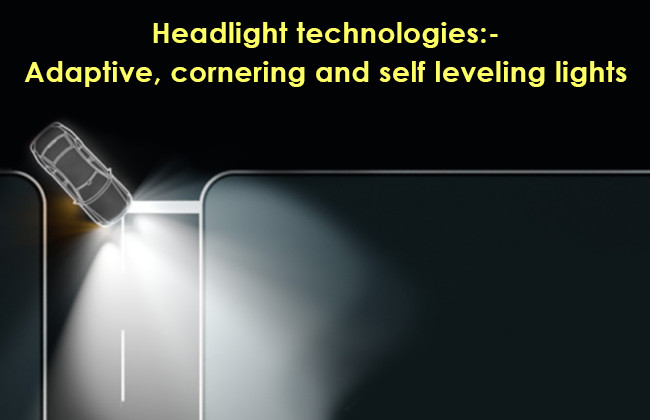Last Updated on November 25, 2025 by Aaron Blake
Have you ever driven at night and wished your headlights could see around corners or adjust to changing road conditions? Adaptive headlights do exactly that, making your nighttime driving safer and easier.
But how do these smart lights work? Understanding how adaptive headlights respond to your steering and the road ahead can change the way you think about night driving. Keep reading to discover the technology behind these innovative headlights and how they protect you on every twist and turn.

Credit: www.cardekho.com
Contents
Basics Of Adaptive Headlights
Adaptive headlights improve night driving by adjusting light direction. They help drivers see better on curves and hills.
These headlights use sensors and motors to move the light beam. This makes driving safer in the dark.
Types Of Adaptive Headlights
There are different kinds of adaptive headlights. Each type changes the light in a unique way.
- Swiveling headlights turn the light with the steering wheel.
- Matrix LED headlights turn parts of the light off to avoid blinding others.
- Dynamic bending lights shift the beam side to side on curves.
- Automatic high beams switch between high and low beams based on traffic.
Key Components
Adaptive headlights have several parts that work together. These parts help control the light direction and intensity.
- Sensors detect the car’s speed and steering angle.
- Motors move the headlight lenses or the whole light unit.
- Control units process sensor data and send commands to motors.
- LED or HID bulbs provide bright and clear light.
- Cameras can detect oncoming vehicles to adjust beam intensity.
Technology Behind Adaptive Lighting
Adaptive headlights improve night driving safety. They adjust the light beam to the road and environment.
This system uses smart technology to detect driving conditions and change the light direction and intensity.
Sensors And Cameras
Sensors and cameras collect data about the car’s surroundings. They detect other vehicles, road curves, and obstacles.
- Light sensors measure ambient brightness.
- Speed sensors track vehicle speed.
- Cameras identify traffic and road shapes.
- Steering sensors detect the angle of the wheels.
Control Systems
The control system processes data from sensors and cameras. It adjusts the headlights in real time for better visibility.
| Control Component | Function |
| Microprocessor | Analyzes sensor input |
| Actuators | Move and tilt the headlights |
| Software Algorithms | Decide light beam pattern |
| Communication Bus | Connects sensors and controls |
Benefits For Night Driving
Adaptive headlights adjust the car’s lighting to the road. They help drivers see better in the dark. This makes night driving easier and safer.
These headlights change direction and brightness based on speed and steering. They improve the driver’s view without blinding others.
Enhanced Visibility
Adaptive headlights shine light exactly where drivers need it. They turn with the car to illuminate curves and corners. This gives a clearer view of the road ahead.
- Better light on winding roads
- Clearer view of signs and obstacles
- Improved vision in bad weather
- Less glare for oncoming traffic
Improved Safety
Adaptive headlights help drivers react faster to dangers. They reduce accidents by lighting up potential hazards early. This feature is especially helpful on dark or rural roads.
| Safety Feature | Benefit |
| Automatic Beam Adjustment | Prevents blinding other drivers |
| Curve Lighting | Improves vision around bends |
| Speed-Based Brightness | Matches light to driving speed |

Credit: www.teslarati.com
Future Trends In Headlight Technology
Adaptive headlights are changing how cars light up the road. New trends show how smart technology improves safety and visibility. These lights adjust automatically for better driving in all conditions.
Future headlights will work closely with advanced car systems. They will use smart sensors and software to help drivers see better and avoid accidents.
Integration With Autonomous Vehicles
Self-driving cars need smart headlights to function well. These lights will communicate with other car systems to improve safety. They can change beam patterns based on traffic and road conditions.
- Detect obstacles and adjust brightness
- Signal other vehicles and pedestrians
- Work with sensors to guide the car safely
- Adapt to weather and light changes automatically
Smart Lighting Innovations
New lighting technology uses LED and laser lights for better control and brightness. Smart systems can create custom light patterns for different driving needs.
| Technology | Benefits |
| LED Headlights | Energy efficient and bright |
| Laser Headlights | Long range and precise beam |
| Matrix Lighting | Blocks glare for other drivers |
| Camera-Controlled Lights | Adjust beam for road and traffic |

Credit: www.youtube.com
Frequently Asked Questions
What Are Adaptive Headlights In Cars?
Adaptive headlights adjust their direction and intensity based on driving conditions and steering.
How Do Adaptive Headlights Improve Night Driving?
They enhance visibility by lighting curves and dimming for oncoming traffic.
Do Adaptive Headlights Work In All Weather Conditions?
Yes, they function well in rain, fog, and clear weather to improve safety.
What Technology Controls Adaptive Headlights?
Sensors, cameras, and motors work together to move and adjust the headlights.
Are Adaptive Headlights Worth The Extra Cost?
They boost safety by improving vision but cost varies by vehicle and model.
Conclusion
Adaptive headlights improve night driving safety and comfort. They adjust light direction as you turn or change lanes. This helps you see curves and obstacles clearly. Cars with these headlights reduce glare for other drivers. The technology uses sensors and motors to move lights smoothly.
Many modern vehicles include adaptive headlights for better visibility. Understanding how they work can help you appreciate their value. Safer drives start with smarter lighting. Simple but effective.





